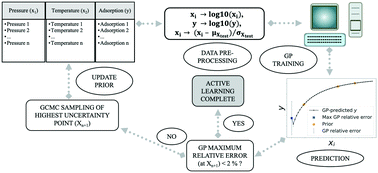Sequential design of adsorption simulations in metal–organic frameworks†
Abstract
The large number of possible structures of metal–organic frameworks (MOFs) and their limitless potential applications have motivated molecular modelers and researchers to develop methods and models to efficiently assess MOF performance. Some of the techniques include large-scale high-throughput molecular simulations and machine learning models. Despite those advances, the number of possible materials and the potential conditions that could be used still pose a formidable challenge for model development requiring large data sets. Therefore, there is a clear need for algorithms that can efficiently explore the spaces while balancing the number of simulations with prediction accuracy. Here, we present how active learning can sequentially select simulation conditions for gas adsorption, ultimately resulting in accurate adsorption predictions with an order of magnitude lower number of simulations. We model adsorption of pure components methane and carbon dioxide in Cu–BTC. We employ Gaussian process regression (GPR) and use the resulting uncertainties in the predictions to guide the next sampling point for molecular simulation. We outline the procedure and demonstrate how this model can emulate adsorption isotherms at 300 K from 10−6 to 300 bar (methane)/100 bar (carbon dioxide). We also show how this procedure can be used for predicting adsorption on a temperature–pressure phase space for a temperature range of 100 to 300 K, and pressure range of 10−6 to 300 bar (methane)/100 bar (carbon dioxide).



 Please wait while we load your content...
Please wait while we load your content...
